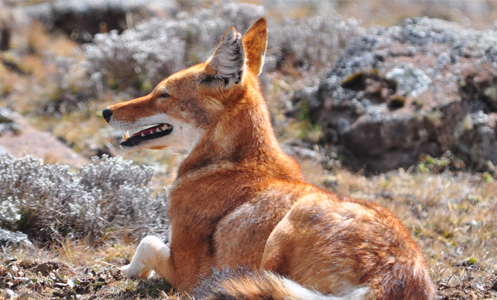ACT - Volume 9 Issue 1
<<< Back to Table of Contents
Wildlife Management in Ethiopian Universities: Can a Pen Move Mountains?
By Murali Pai and Tekele Serekebirhan
Africa has been and will be the poster child of global biodiversity for ages. One-fourth of Africa’s biodiversity is in Ethiopia, and is comprised of 320 mammals, 860 birds, 240 reptiles, 71 amphibians, 150 freshwater fish, and over 1,225 arthropods and 6,600 plant species with a high rate of endemism. The endemic wildlife include the Ethiopian wolf and Swayne’s hartebeest, Prince Rasploi’s turaco and Stresemann’s bush crow, Bale mountains heather chameleon and the Ethiopian mountains adder, and the Ethiopian banana frog and Bale mountains moss frog. There are diverse habitats ranging from 110 meters below sea level at Kobar Sink in the Afar depression, to a peak of 4620 meters above sea level at Ras Dejen in the Siemen Mountains. The high relevance of wildlife management in Ethiopian Universities is therefore a given.
 |
|
Ethiopian wolf. Photo credit: Ludwig Siege |
Wildlife management can be defined as art and science of managing wildlife populations and their habitats with the participation of stakeholders. Much as wildlife science is an integral part of Ethiopia’s 33 universities and some 100 other colleges, it was only 4 years ago the country’s first Master’s program in wildlife management was offered at the Wondo Genet College of Forestry and Natural Resources. A second program is nearing launch in March 2014 at Arba Minch University, also in southern Ethiopia. The prerogative of managing wildlife and wild lands in the second-most populous country in the continent is vested with over 80 ethnic groups with some 200 spoken dialects, diverse cultural values and social mores with the GDP per capita estimated to be $1200 in 2012. Seemingly, food security, water, health and infrastructure take precedence over biodiversity. These challenges are compounded by climate change impacts; resource degradation and subsistence hunting make wildlife management a daunting task.
The Protected Areas of Ethiopia are closely hemmed-in and utilized by the agrarian and pastoralist communities. There are 20 National Parks, 3 Wildlife Sanctuaries, 2 Wildlife Reserves, 19 Controlled Hunting Areas, and 10 Open Hunting Areas till date. Yet, only 2 National Parks – the Simien and Awash are gazette notified. The potential for biodiversity stewardship via payments for ecosystem services schemes (PES) is yet to be realized and this could be the future of conservation. The risks of emerging diseases are stark and there is urgent need for research at the interface of wildlife, people and ecosystems, or ‘one health’. Wildlife management empowers its practitioners with tools to try and tackle such critical issues. Although human dimensions can overwhelm science at the roof of Africa, a formidable combination of skilled biologists and committed wildlife managers can move the mountains beyond mountains.
This article was published in the J Biodivers Endanger Species 2014, 2:1
Digital Object Identifier: http://dx.doi.org/10.4172/2332-2543.1000e112